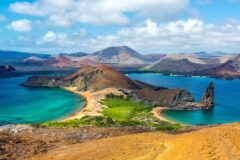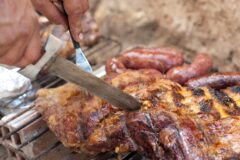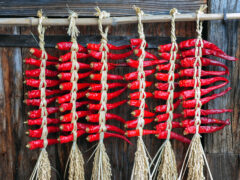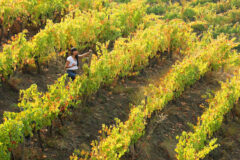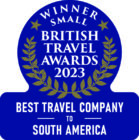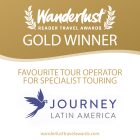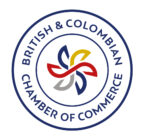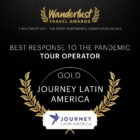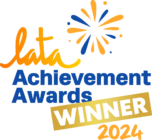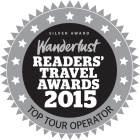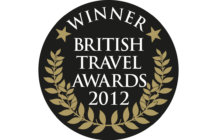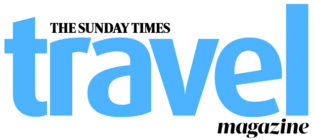Private Journeys
Treasures of Peru: The archaeological riches of the north
15 days from £4,600pp
(based on two people sharing & excluding flights)
Itinerary
 Map
Map
Day 1
Arrive in Lima. Transfer to hotel in the Pacific coast district of Miraflores.
You will be met at the airport and escorted to your hotel on the Pacific-side residential and commercial district of Miraflores by one of our local representatives.
Lima is a vast, complex metropolis, with a history dating from the era of its wealth and importance to Imperial Spain to its current status as a dynamic, growing city of trade, industry and tourism.

Stay at -
Antigua Miraflores
Day 2
Visit the Larco Museum.
Visit the Larco Museum, one of our favourites in Latin America, where exhibits are beautifully displayed in a colonial building with flowery patios and a smart restaurant.
The museum houses an astonishing private collection of pre-Columbian ceramic pieces. The comprehensive range of pottery items shows you just how Peruvian culture developed over the centuries. There are particularly good examples from the exotic Moche, Sicán and Chimú cultures, and in fact this is the world’s largest collection of artifacts from the eras of their ascendancy.
It’s not all about pots though – there are displays of gorgeous textiles, intricate gold and silver work and haunting mummies, all left behind by by highly artistic pre-Inca civilisations. and on top of it all, there’s an extensive and unique collection of erotic figurines.

Stay at -
Antigua Miraflores
Day 3
Discover the pre-Columbian site at Caral.
Depart Lima by road for 3 hours to the UNESCO World Heritage Site, Caral, a city 26km inland from the coast founded circa 2,600BC. It is a monumental construction which is overturning many of the accepted theories of Peruvian archaeology. Indeed, it is believed to be the oldest city in South America.
The arid site lies on the southern fringes of the Supe Valley, where further ruins are continually being revealed. There’s time to explore this remarkable ancient city which, in complete isolation from other cultures, managed to reach an unparalleled degree of sophistication, with religion as the binding factor of control and social cohesiveness. Return to Lima.

Stay at -
Antigua Miraflores
Day 4
Fly to Trujillo; city tour, visit the Archaeology Museum.
Fly to Trujillo, set in a coastal oasis, in the morning. In the afternoon there’s a guided tour of this port city, which has an attractive colonial heart. Visit this historical centre including the ‘Plaza de Armas’ and its cathedral which was built in 1647. Surrounding it are a number of attractive mansions from the Spanish colonial era.
Afterwards, continue to the archaeological museum run by the National University of Trujillo. The collection is installed in a 17th century house featuring seven rooms of artefacts from the pre-Columbian cultures of northern Peru, in chronological order.

Stay at -
Casa Andina Standard Trujillo
Day 5
Visit Huacas del Sol and de la Luna and the Chimu city Chan Chan.
Discover two temples 5km from Trujillo which date to the Moche Culture. Firstly visit the 1,500-year-old Huaca del Sol (Temple of the Sun), built with many millions of moulded adobe bricks. Directly opposite, the Huaca de la Luna (Temple of the Moon) dazzles with its decorated walls and impressive friezes.
Have lunch at a restaurant on the coast at Huanchaco Bay, where fishermen continue to venture out to sea in fragile straw skiffs. In the afternoon, take a tour of Chan Chan, the extensive pre-Columbian adobe citadel of the Chimú empire, considered the largest of its kind at over 20km2.
The partially restored city gives a true insight into ancient Peruvian civilisation. It was founded somewhere between 850 and 1300AD – no-one is sure, but it is older than the Inca empire which subdued it in 1470. At the apogée of the city’s influence it housed somewhere between 30,000 and 60,000 people and stored a wealth of gold, silver and pottery.

Stay at -
Casa Andina Standard Trujillo
Day 6
Private road transfer to Cajamarca via El Brujo.
Into the Andes: it’s a drive of at least 6 hours (excluding stops) to Cajamarca – a beautiful trip. The sinuous road rises from the austere rocky desert of the coast through green valleys carved between the steep mountain walls of the Andes. Simple farmsteads and livestock dot the bucolic landscape. En route to Cajamarca, you’ll visit El Brujo – “Temple of the Wizard”- a Moche-built complex of adobe temples, where the Señora de Cao, a mummified, tattooed female Moche leader was discovered, and is on display.
The graceful colonial town of Cajamarca is the commercial centre of Peru’s northern highlands, and lies in a fertile, flowery region of cattle pasture. One of the biggest cities in the Inca empire, Cajamarca was the place where Pizarro ambushed and put to death the emperor, Atahualpa.

Stay at -
Hotel Laguna Seca
Day 7
Guided excursion to Cumbe Mayo.
Within easy reach of the town are the pre-Inca aqueduct and petroglyphs of Cumbe Mayo, the highlight of today’s excursion.
Visit the colonial hacienda of La Collpa, a cooperative farm owned by the Ministry of Agriculture, which breeds cattle and is set amidst attractive lakes and gardens. The tour then continues to the picturesque Andean village of Llacanora, visiting the nearby cave paintings, before arriving at the pre-Inca aqueducts of Cumbe Mayo.
These water channels run for several kilometres and are said to be the oldest man-made structures in South America. From this isolated plain at 3,600m you can also appreciate the enormous and unusual rock formations of the area. The tour finishes with a visit to the pre-Inca ceremonial site of Layzón, which dates back to 200 BC.

Stay at -
Hotel Laguna Seca
Day 8
Road transfer to Leymebamba.
By road to the agreeable town of Leymebamba. The spectacular route twists and turns through varied scenery – rolling hills, verdant farm terraces and arid mountain landscapes. Drive up to the lip of the Marañon Canyon before the long descent to the river below. Crossing the river at Balsas, you ascend 3,600m up the eastern side of the canyon. From the top, it is 50 minutes down to the village of Leymebamba. The drive takes about 9 hours in total, travelling via the market town of Celendín, famous for its straw hats.

Day 9
Visit Leymebamba Museum, the tombs of Revash and continue to Chillo.
In the morning visit Leymebamba Museum which houses over 200 mummies found at Laguna de los Cóndores in 1997. Drive to Yerbabuena, followed by a 2-hour steady walk uphill to enjoy a close-up view of the spectacular tombs of Revash. This extremely photogenic site is perched on a yellow cliff and the tombs resemble miniature houses, with rust red pictographs. The site dates back to 1,200 AD. Continue on to Chillo, an hour’s drive away following the line of the Utcubamba River.
Day 10
Full day guided expedition to hilltop Kuelap.
The Chachapoyan civilisation (from 0AD onwards) was organised into a system of chiefdoms which left behind a series of sophisticated cities even more grand and mysterious than those of the Incas.
You start early for the two-hour drive up to the citadel of Kuelap. The all-weather road winds round the mountain opposite – and as you climb, you begin to appreciate the feat of manpower and engineering which built the towering walls that completely encircle the whole of the elongated hilltop above.
For those looking for something a little bit different, the recently inaugurated Kuelap cable car adds a new dimension to a visit to the site. The telecabinas cross the valley in just 20 minutes, which means the overall journey time is about 30 minutes shorter than when travelling by road and the magnificent views across the valley ensure a scenic start to your Kuelap experience.
When you get there you’ll be overwhelmed by the vast scale of the place. It’s atmospheric too: occasional shafts of sunlight may pierce the mist which swirls through the massive stone ramparts and cloud forest. You’re just a few degrees south of the equator, but here at 3,030m the climate is cold yet humid.
The monumental limestone redoubts enclose temples and dozens of roundhouses the construction of which started in about 500AD. and continued up to Inca times. The renowned historian John Hemming describes Kuelap thus: “of all the ruins in Peru…the most spectacularly defended, the strongest by European standards of fortification”. Yet recently, speculation has focused on the site as being less of a defensible fortress and more of a ceremonial centre. Judge for yourself, as you explore the complex and enjoy the views over the river far below.

Stay at -
Hotel la Xalca
Day 11
Land transfer to Chachapoyas via Karajia.
Take a morning drive to the tiny hamlet of Caserío Cruz Pata, the starting point for a 45-minute walk to the archaeological site at Karajía, the burial place of some of the elite Chachapoya warriors. The site is known for the colossal sculptured sarcophagi: some of these statues, carved into the rock face, are up to 2.5m tall, and intricately decorated.
In the afternoon drive to Chachapoyas, a pleasant town which lies at a highland crossroads between the Amazon basin and the coast and is named after the mysterious Chachapoya civilisation, about which little is known but which has left a vast and rich archaeological heritage in the region.

Stay at -
Gocta Andes Lodge
Day 12
Trek to Gocta Falls. Overnight at Cocachimba.
Travel by road to the small town of Gocta to begin the hike to the Gocta waterfall. Walk through a cloudforest, which is home to orchids, giant ferns, yellow-tailed woolly monkey, mountain sloths and the cocks-of-the-rock.
Set over two drops measuring 771m, the fall was unknown outside the immediate surrounding villages until a German explorer spotted them from afar in 2005. He measured them and discovered they were the third-highest falls in Peru.. Overnight in Cocachimba, the closest village to the falls.

Stay at -
Gocta Andes Lodge
Day 13
Road transfer to Chiclayo.
Continue by road to Chiclayo. It is a 9-10-hour drive through the narrow Utcubamba canyon and into the foothills of the Andes finally arriving at Chiclayo, an important port on the north Pacific coast. It is also situated in one of Peru’s most important agricultural regions.
Day 14
Visit Sipán, Tumbas Reales and Sican Museums, Túcume.
Situated 35km from Chiclayo, Sipán is an extensive burial site of the Moche culture – a civilisation that flourished on the north coast of Peru between 100 and 800AD. Several royal tombs, filled with 1,700-year-old funeral offerings of the Moche culture, were uncovered containing pieces worked in precious metals, stone, pottery and textiles.
The most startling discovery of the original excavation was of an entombed Moche leader, who became known as the Lord of Sipán.
This was followed by the finding of an even older tomb – predating the former by 200 years. There is a site museum featuring details of the excavation work and replicas of some of the finds.
Later, visit the Royal Tombs of Sipán Museum where the original pieces are now exhibited. The museum, 17km from Chiclayo, is a replica of the Moche pyramid under which the tombs were found.
In the afternoon, travel to Ferreñafe, 18km north of Chiclayo, where the Sican Museum’s reconstruction of the Lambayeque tomb provides visitors with an unparalleled insight into this complex culture. The exhibition covers everything from daily domestic life to craftsmanship and manufacturing processes used to produce the distinctive gold and ceramic works of art.
The museum also provides the perfect introduction to the next part of the excursion: a trip to Túcume, a vast Lambayeque archaeological complex, known as the Valley of the Pyramids. The settlement appears to date back to around 1,000-1,100AD with the largest and most impressive structures found in the monumental sector to the north and northeast of La Raya Mountain.

Day 15
Fly to Lima and connect with international flight home.
Fly to Lima and connect with international flight home.
Outline itinerary
Day 1
Arrive in Lima. Transfer to hotel in the Pacific coast district of Miraflores.
Day 2
Visit the Larco Museum.
Day 3
Discover the pre-Columbian site at Caral.
Day 4
Fly to Trujillo; city tour, visit the Archaeology Museum.
Day 5
Visit Huacas del Sol and de la Luna and the Chimu city Chan Chan.
Day 6
Private road transfer to Cajamarca via El Brujo.
Day 7
Guided excursion to Cumbe Mayo.
Day 8
Road transfer to Leymebamba.
Day 9
Visit Leymebamba Museum, the tombs of Revash and continue to Chillo.
Day 10
Full day guided expedition to hilltop Kuelap.
Day 11
Land transfer to Chachapoyas via Karajia.
Day 12
Trek to Gocta Falls. Overnight at Cocachimba.
Day 13
Road transfer to Chiclayo.
Day 14
Visit Sipán, Tumbas Reales and Sican Museums, Túcume.
Day 15
Fly to Lima and connect with international flight home.
Inspired by this trip
Our exciting range of articles on Latin America explore everything from iconic destinations and lesser-known cultural gems to delicious traditional recipes. You’ll also find exclusive travel tips, first-hand client reviews and the chance to get your personal questions answered by our travel experts.
Papagaio
Your edit for Latin American inspiration
Our exciting range of articles on Latin America explore everything from iconic destinations and lesser-known cultural gems to delicious traditional recipes. You’ll also find exclusive travel tips, first-hand client reviews and the chance to get your personal questions answered by our travel experts.
View Extraordinary Inspiration